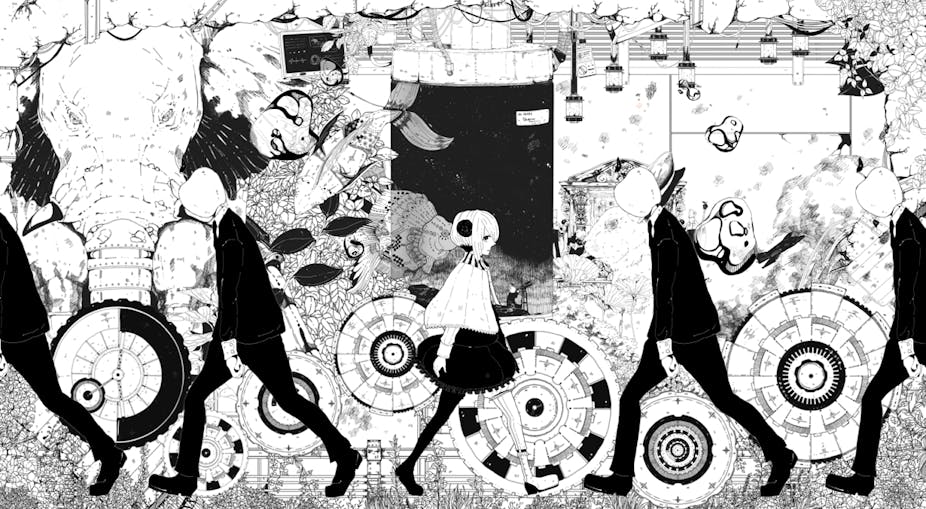We increasingly use animation to inform, explain and instruct. It is used to present evidence in courtrooms, teach about scientific phenomena and provide dynamic assembly or operation manuals.
But do animations actually work?
One reason for the burgeoning use of animations is that advances in digital technology have made their development and distribution far easier than ever before. For most of the 20th century, developing animations was a very slow, specialised, labour-intensive process.
The Disney classic Snow White and the Seven Dwarfs took teams of skilled artists and technicians four years to produce. The distribution of such animations was essentially limited to cinemas.

Things have changed radically in recent years. Now, any one of us can develop and distribute our own animations using mobile phone apps such as Doink Express or Animation Creator.
Part of the appeal of animations is that they are an attractive and engaging way to communicate. But their popularity is not just a matter of entertainment value.
As the work of companies such as Digizyme shows, business and education have been quick to adopt animation as a tool for presenting information, making difficult ideas more accessible and teaching people new skills.
The shift from traditional forms of information to animated graphics is driven by a widespread assumption that animations are a more effective way of communicating. Weather maps are a good example.
Only a few years ago, TV weather bulletins had a presenter standing by a static map using words and gestures to explain what the isobars, cold fronts and pressure cells were doing.
Today, weather maps are animated so that we can see directly how these features move and change over time.
If a single picture is worth a thousand words, television producers seem to believe animated pictures are worth a whole lot more.
Animations certainly have the potential to help us understand things. But recent research suggests there can be downsides.
One problem is that our perceptual system is tuned to preferentially pick up information that contrasts with its surroundings.

Think about a cold front on a weather map (shown as a bold line with barbs pointing out of one side). Not only does it have a highly characteristic shape (compared with the surrounding mass of “anonymous” isobar lines), but it also moves in a very distinctive way.
These visual and dynamic properties make it stand out from the rest of the weather map so it’s difficult for us not to notice it. But trained meteorologists are not seduced by this highly conspicuous feature – they also search out other changes in the weather map pattern that are far more subtle.
They know these less-obvious events – such as subtle changes in isobar spacing - can be just as important (or even more so) in predicting the forthcoming weather.
Unfortunately, we non-meteorologists miss such events because what we notice is largely ruled by our perception. In particular, we tend to pick out things that move and change a lot but overlook those that don’t.
Help or hindrance?
So, the very dynamic character that gives animation its power to make information more accessible may also prevent us from picking up important information.
As mentioned already, this can be a real problem when the person viewing the animation is not an expert in the subject matter being presented.
This, of course, is exactly the situation in which we often find ourselves, because animation tends to be used to introduce content to those who don’t know much about a given subject.
Education and training are common examples – the teacher thinks the animation is self-explanatory because “it shows the students exactly what happens”.
Unfortunately, merely exposing information to learners is often not enough, especially when complex, unfamiliar dynamic subject matter is involved.
Animation is not a magic bullet that produces instant understanding solely because it depicts things exactly as they happen.
For explanatory animations to be effective, their design must take account of the way human beings actually perceive dynamic information.
Animations need to be designed such that they compensate for our tendency to miss important but perceptually subtle events.
Most of the informative animations produced today are designed on the basis of personal intuition rather than according to research-based principles that reflect human information processing. This is because research into how people process animations began only relatively recently.
Simply presenting an accurate and complete animated depiction of a phenomenon may not be sufficient to help people understand it.
Research suggests that animations may also need to direct viewers’ attention explicitly, rather than expecting them to find key information for themselves.
It’s no wonder that many animations prove to be far less effective than expected.

But there is hope on the horizon. Animation undoubtedly has the potential to help people comprehend things that are difficult to understand when presented via text or static pictures.
Researchers are finding new ways of designing animations that incorporate guidance for viewers so they can be directed to the key information without being distracted by what is simply most noticeable.
One example is progressive path cueing – a technique that leads viewers along important cause-effect pathways through the subject matter highlighting important aspects as it goes.
Ironically, some of the techniques proving to be successful are extensions of the pointing and dynamic hand gestures that traditional weather presenters used when guiding our attention through those old fashioned static weather maps.
Seems they may have been on to something after all.

